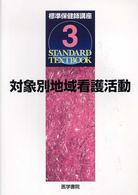- ホーム
- > 洋書
- > 英文書
- > Computer / General
Full Description
Build analytics for video using TensorFlow, Keras, and YOLO. This book guides you through the field of deep learning starting with neural networks, taking a deep dive into convolutional neural networks, recurrent neural networks, and long short-term memory (LSTM) networks. Video Analytics Using Deep Learning closes with practical examples of building image filters and video masking using generative models. The examples within the book cover topics from domains such as traffic recognition for self-driving cars; face recognition and emotion analysis for retail analytics; object and tamper detection for safety and security; and image filters and video masking for social networks and web applications. To enable you to make a smooth transition into deep learning, the book covers mathematical pre-requisites and includes an introduction to deep learning. You'll also cover topics such as storage of large video content for processing on the cloud and working with the connectors involved. All the code and samples in the book are provided as iPython. What You Will LearnMaster TensorFlow, Keras, and YOLOWork with face recognition, age detection, and gender identificationApply CNN, RNN and generative models in deep learningUse emotion analysis and gesture detectionCarry out traffic recognition in real-timeWho This Book Is ForData scientists and machine learning developers looking to build applications based on video in finance, healthcare, automotive, transport, safety/security, and home automation.
Contents
1. Deep learning Goal: Learn basic manipulation like assigning variables, matrix multiplication, transpose of matrix, resizing vectors and matrices etc.Pages: 201. Introduction to tensorflow/keras1.a. Defining Tensors1.b. Basic operation using tensorflow1.c. Session logging and Variables1.d. Tensor Board1.e. Basic operation using keras2. Introduction to neural networkGoal : Solve the problem beyond conventional algorithmic approach. In this chapter we will learn about the procedure that is used to compute gradients of a loss function (Backpropagation). We will learn new classification technique called neural network. We will also learn various loss function and optimization methods that helps to measure the quality of parameters and will help to find how much output is agreed with ground truth.Pages : 502.a. Loss function2.b. Optimization (SGD, RMSPROP, ADAM, Quantum Gradient Descent)2.c. Backpropagation2.d. MultiLayer Perceptron3.e. Lets Build: A classifier on Fashion MNIST to classify the clothes3. Introduction to convolution neural networkGoal: We will learn new pattern recognition techniques mainly for images that can be used for classification and segmentation.Pages: 25FC Vs CNN 3.a. Convolution Layer 3.b. Activation Layer3.c. Pooling Layer3.d. Dropout3.e. Let's classify/recognise object using CNNetc..4. CNN architectureGoal : To learn various deep learning framework with different depth of layers and size of filter and its use case to increase the efficiency depending on requirements. Pages: 754.a. AlexNet4.b. Google LeNet4.c. VGG16 (OxfordNet) architecture4.d. Let's build model like Face recognition, Emotion analysis using above mentioned architectureetc..5. Image captioning and Generative modelsGoal : To learn the action from figure. In this chapter we will learn how to get textual description of an image.In this chapter we will also learn Unsupervised learning and in particular Generative models. Given sample X and Y as input and output we will learn way to sample these X, Y pairs means from input data we can generate different types of probabilistic data. We will learn to generate new image, given input imagePages: 905.a. RNN5.b. LSTM5.c. Let's find what picture tells us (Gesture Recognition or Traffic vision).5.d. Density estimation and its types (how data is distributed, identifying hidden structure of data)5.e. Generative adversarial network5.f. Pixel RNN/CNN5.g. Variational Autoencoders5.h. With given input let's generate random faces using generative model








